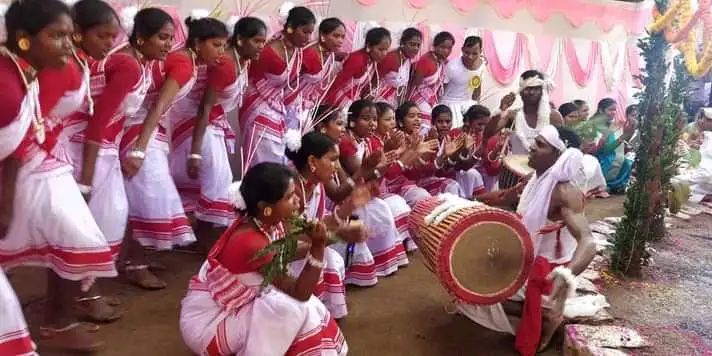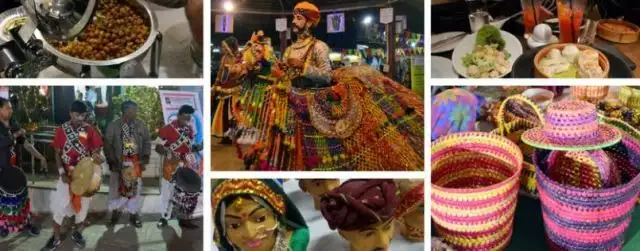Jharkhand was initially a part of Bihar but is now an independent state. Tribals reside here since the very beginning. Their culture and way of life is now catching the attention of many travelers. Music, art, and dance form an integral part of the culture. In this article, we will read about some of the festivals celebrated here.
Jharkhand
1) Sarhul
“Sar” means year, and “hul” refers to commence. Sarhul is the tribal New Year celebrated by the Oraon tribe in which nature and earth are worshipped. The Sal tree is worshipped as sal flowers symbolize new revival. The Sal and other forest trees are blooming during this time. The tribal community uses leaves of trees, flowers, paddy, and fruits after offering them to the deity. On the first day, people clean and decorate the area where tribals gather for worship. The second day commences with the priest starting his fast after taking a bath in the morning. Three earthen pots are filled with water, and the puja starts. The water level is checked, and based on that predictions are made about the amount of rain etc. The priest is carried by the village boys on their shoulders to his home. His wife washes his feet and he blesses everyone. Women dress in red and white sarees and lead the procession. You can purchase these traditional sarees here https://amzn.to/3UDXkc3
When– March or April
Where– Ranchi
Experience– People dance and sing traditional songs at the designated place of worship. Rice beer is offered as Prasad to the devotees. The experience is of a simple festival that reminds us of our roots and the importance we should give to nature.

Women dancing to dhol during Sarhul festival. Photo credit: theindiantribal.com
2) Sohrai
Sohrai is important for Adivasis in Jharkhand. It is a winter harvest festival, celebrated when the paddy is ripe. Sohrai continues for 3-5 days, with the first day being celebrations mainly for men. Men perform a ritual to commence the festival. They eat khichuri and drink rice beer. On the second day, cattle are sent for grazing in the morning. During that time, women decorate their huts by painting them. Cattle are welcomed, their horns are oiled, and garlands are tied. Cattle sheds are worshipped. Everyone celebrates together on the fourth day. Women decorate their walls with murals of Sohrai arts. These paintings are believed to bring good luck, and are transferred from mother to daughter. You can get your hands on these beautiful Sohrai arts paintings to decorate your home also. https://amzn.to/3C6Qjco
When– November
Where– Hazaribagh district of Jharkhand
Experience– One can appreciate the artistic skills of the women, as walls are decorated with Sohrai arts, using natural colors in mud. Villagers sing songs and appreciation is shown, for cattle and livestock.

Cattle worship as a part of Sohrai. Photo credit: travelwhistle.com
3) Chhath Puja
Chhath Puja is celebrated to thank God for life on earth. The Sun God, and his wife are worshipped. Devotees fast and pray to the rising and setting sun while standing in a water body like a river or pond. Devotees take a dip in the river and then take the holy water home with them to prepare offerings. The second day involves a full day of fasting that ends a little after sunset. Third day is preparation of Prasad, placed in traditional bamboo trays. Bamboo trays for Chhath Puja are available here https://amzn.to/3DRGNv0 Thekua, coconut, banana, and other fruits are kept on the tray. On the fourth day, women gather on the banks of the river or ponds and offer Prasad to the rising sun. They break their 36 hours fast by eating ginger and sugar. Food prepared on this day includes Kaddu Bhaat, Hara Chana, rice kheer, and Kesar ka laddu.
When– October
Where– Jharkhand
Experience– Devotion is at its peak as women fast for 36 hours and wait in procession to break their fast by praying to the sun God while standing in the water of a river or pond.

Women praying during Chhath Puja. Photo credit: dnaindia.com
4) Karma festival
Karma festival or Karam as it is locally known is where devotees worship Karam Devta. Tribes of Oraon, Bhijwari, Bhaiga, and Majhwar consider this day holy. Sisters appeal to God for the prosperity of their siblings, and pay tribute to the Karam tree. This tree is a symbol of fertility and prosperity. Before the festival, youngsters cut a branch of the Karam tree, then carried by unmarried women who have fasted for the day. The tree branch is placed at the center of the ground, decorated with flowers, and plastered with cow-dung. Traditional songs are sung to the deity, and garlands placed on the branches. Karma festival gives the message to everyone that trees must be worshipped and saved, as we need them for survival.
When– August or September
Where– Jharkhand
Experience– Dancers put their hands around each other’s waist and dance through the night. The branch is passed on to each other while dancing. It is fascinating and informative when elders tell the story of Karma Puja.

Worship of the branch of the Karam tree during Karma festival. Photo credit: kudumi.org
5) Aadi Mahotsav
Aadi Mahotsav is organized under the joint effort of the Ministry Of Tribal Affairs and TRIFED. Tribal craftsmen from many other states attend the festival and display their art for sale. Things like sarees, clothes, brass art, dokra art, lacquer bangles, bamboo items, etc are available. There are also artifacts like Warli-style paintings and Pattachitras. You can also own the beautiful Pattachitras paintings by purchasing them from the comfort of your home. https://amzn.to/3dCLluG The aim of the festival is to keep the civilization and culture of the tribals intact. Food items like a dumpling, peels, dhuska, pitha and madua roti are also available. Tribals are very connected to nature, and their simplicity is seen in their food.
When– February or March
Where– Ranchi
Experience– Glimpses of the rich tribal life philosophy are seen through the festival. One can enjoy shows on tribal history, anthropology, literature, etc.

Art on display at Aadi Mahotsav. Photo credit: krishijagran.com
6) Tusu Mahotsav
Tusu Mahotsav is a harvest festival celebrated after harvesting paddy and rosemary in winter. Unmarried girls decorate a bamboo or wooden frame with colored paper. It is then gifted to the hilly river nearby. Tribal songs are sung, that showcase the simplicity and innocence of tribals. Tusu Mahotsav is the heritage of Jharkhandi culture. Preparations for it start a month in advance. Young girls make clay idols. “Chaudal” which is a traditional pavilion, is decorated. This is all done by unmarried women. People sit together and eat specialties like gud pitha(pancake), roti pitha, and mudhi lai. Gud pitha can be made at home with jaggery available here https://amzn.to/3fk65Yg
When– January
Where– Bundu, Tamar and Raidih area.
Experience– There are Tusu fairs and exhibitions to enjoy in various areas. Women dance to dhol and temple bells.

Tusu Mahotsav celebration. Photo credit: sahapedia.org
7) Bhagta Parab
Bhagta Parab is also known as the worship of Budha Baba. People fast during this day. The Pahan (priest) bathes in the pond. The devotees then interlock their thighs, and the Pahan walks over their bare chest. On the next day, primitive sports showcasing bravery take place. Devotees tie themselves to one end of a long wooden pole that is hanging on a vertical wooden pole. The other end is tied with a rope tightened by people. The devotees perform creative dance forms while in the sky.
When– between spring and summer
Where– Tamar region of Jharkhand
Experience– Enjoy the mind-blowing chhau dance performances that include gymnastic actions.










